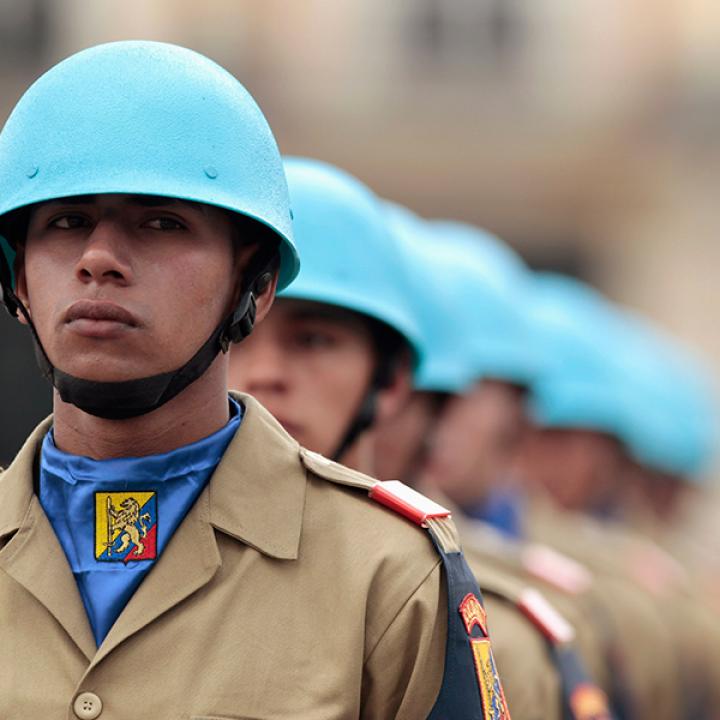
- Policy Analysis
- Policy Focus 45
International Military Intervention: A Detour on the Road to Israeli-Palestinian Peace

The key ingredient for a successful peace effort is not a foreign peacekeeping force—regardless of how robust its presence or how broad its mandate—but rather the willingness of each side to honor its commitments to prevent violence.
As Israeli-Palestinian relations experienced an "Aqaba summer" in 2003, attention turned to the idea of dispatching foreign peacekeepers to maintain or even impose calm between the two sides in the West Bank. The proposal received serious consideration and even praise from UN and NATO officials, leading members of Congress from both parties, and prominent columnists.
Given the possibility that intervention may eventually assume a more important role in the policy debate over the Arab-Israeli peace process, The Washington Institute asked its senior research staff to examine the issue from a range of historical, operational, and political angles. This collection of essays, edited by Institute executive director Robert Satloff, is the result of that effort.
From the Introduction
The principal conclusions from these essays can be summarized as follows. First, the key ingredient for a successful peace effort is not an International Intervention Force (IIF)—regardless of how robust its presence or how broad its mandate—but rather the willingness of each side to honor its commitments to prevent violence. Deployments of international forces in the Arab-Israeli arena have succeeded only when the two parties themselves have been strongly and actively committed to implementing their own previously reached peace agreement.
Second, the prerequisites for a successful deployment, even in the event of a political agreement by the two sides, are daunting. Given the experience of recent interventions around the globe, a deployment to the Israeli-Palestinian arena would require sufficient resources and a strong enough mandate to pursue rejectionist militants for an indefinite period; specifically, a deployment of 34,000–85,000 troops would likely be required. Even so, it is unlikely that such intervention would resolve the “final status” political issues at the heart of the conflict or redress the intercommunal hostility that has worsened considerably in recent years.
Third, an IIF could not possibly undertake the counterterrorism prerogatives of Israel and the counterterrorism responsibilities of the PA without the prior agreement of both parties. Even if acceptable rules of engagement were ironed out between the Israeli military, Palestinian security forces, and international troop commanders, an IIF would still have to meet the following requirements:
- be large enough to demonstrate political commitment, yet nimble enough to respond to multiple challenges in multiple settings;
- be deft enough to establish a network of local agents, yet forceful enough to take quick and decisive action against the full infrastructure of terrorist organizations;
- secure sufficient political backing from contributing nations to deal with potential setbacks (e.g., terrorist attacks; retaliatory strikes that go awry);
- develop a viable “exit strategy”—that is, a plan to root out terrorism so thoroughly, to build up local counterterrorism capabilities so efficiently, and to stabilize and reform the PA so effectively that the West Bank and Gaza do not slip back into violence once international forces depart.
Fourth, in a purely military sense, there is little reason to believe that an IIF would do an appreciably better job than the Israel Defense Forces at fighting terrorism or ensuring security. On various relevant tasks—including arresting wanted men, confiscating weapons, policing flashpoints, and dismantling the socioeconomic infrastructure of terrorist organizations—the uninspiring record of interventions elsewhere does not inspire confidence that even U.S.-led forces in the West Bank and Gaza could fulfill their mission. In fact, deploying an IIF could have negative military repercussions, such as introducing tension into the U.S.-Israeli strategic relationship; increasing the already significant level of anti-Americanism among Palestinians and the wider Arab and Muslim worlds; and transforming the United States from mediator to participant in the Israeli-Palestinian conflict.
Fifth, from a political perspective, opposition to an IIF is deep and strong among Israelis, who would reject the idea in almost all conceivable circumstances. Although many moderate Palestinians support the idea, such views are conditioned on international forces being deployed along the 1967 ceasefire lines; deployment inside the West Bank and Gaza would be viewed as replacing one foreign occupation with another. Under certain circumstances, Israelis might reluctantly accept a force composed entirely of U.S. personnel, but this is precisely the structure that Palestinians oppose the most. Therefore, unless an IIF deployment produced quick results—for Israelis, a speedy end to terrorism; for Palestinians, a rapid end to the Israeli occupation—it would likely lead to the worst-case scenario, provoking enmity from both the Israeli and Palestinian publics.
Sixth, in a diplomatic sense, the deployment of an IIF would almost surely delay the day when peace itself would become possible. That is, such intervention would imply that outside parties could be goaded into shouldering the responsibilities that Palestinians themselves must assume as a prerequisite for peace. Indeed, one likely repercussion of an IIF would be the early demise of the Palestinian political reform movement, which has been the most hopeful trend to emerge from Palestinian society since the beginning of the uprising in September 2000.
Taken together, the analysis in the following essays constitutes a cautionary note regarding the wisdom and practicality of deploying an intervention force to the Israeli-Palestinian arena. Three years of violence have not dampened hopes among many Israelis and Palestinians that the two sides can—with the support, not the interference, of outside actors—resurrect the possibility of resolving their conflict through negotiations.
66 Pages




